Depletion of Heavy Ion Abundances in Slow Solar Wind and Its Association with Quiet Sun Regions
Abstract
:1. Introduction
2. Observations
2.1. Data
2.2. Definition of UDW and NDW
- Outside ICME and buffer time
- Above the threshold of Equation (2) on the O-C plot
- Proton speed less than 500 km s
- Outside ICME and buffer time
- Proton speed less than 500 km s
- C/P ratios are less than the average value in UDW plus one sigma, which is
3. Results
3.1. Comparison of UDW and NDW in Elemental Abundances
3.2. Comparison of UDW and NDW in Heavy Ion Charge States
3.3. Comparison of UDW and NDW in Proton Properties and Magnetic Field
3.4. Solar Cycle Dependence
3.5. Coronal Origins
4. Summary of the Properties of the UDW and NDW
- 1.
- Proton properties: The UDW has similar proton speed, lower proton density and slightly lower proton temperature compared to the NDW.
- 2.
- Magnetic properties: All components including the magnitude of UDW are lowered by about 20% compared to the NDW.
- 3.
- Composition in UDW:
- (a)
- The elemental abundance He/P, C/P, Mg/P, Si/P, O/P, Ne/P, S/P, and Fe/P are all decreased by ∼10–30%;
- (b)
- and are similar as in NDW; whereas are dramatically decreased, resulting that is slightly increased but is greatly decreased.
- 4.
- The monthly occurrence rates of UDW is strongly anti-correlated with the SSN.
- 5.
- The coronal origins of the UDW are mostly associated with quiet Sun regions; while equally amounts (∼35%) of the NDW are associated with the active regions and their boundary and the quiet Sun.
5. Discussion
6. Conclusions
Author Contributions
Funding
Institutional Review Board Statement
Informed Consent Statement
Data Availability Statement
Conflicts of Interest
References
- Von Steiger, R.; Zurbuchen, T.H. Polar coronal holes during the past solar cycle: Ulysses observations. JGR Space Phys. 2011, 116, A01105. [Google Scholar] [CrossRef] [Green Version]
- Ko, Y.-K.; Raymond, J.C.; Zurbuchen, T.H.; Riley, P.; Raines, J.M.; Strachan, L. Abundance variation at the vicinity of an active region and the coronal origin of the solar wind. Astrophys. J. 2006, 646, 1275–1287. [Google Scholar] [CrossRef]
- Liu, S.; Su, J.T. Multi-channel observations of plasma outflows and the associated small-scale magnetic field cancellations on the edges of an active region. Astrophys. Space Sci. 2014, 351, 417–425. [Google Scholar] [CrossRef] [Green Version]
- Zhao, L.; Zurbuchen, T.H.; Fisk, L.A. Global distribution of the solar wind during solar cycle 23: ACE observations. Geophys. Res. Lett. 2009, 36, L14104. [Google Scholar] [CrossRef] [Green Version]
- Zhao, L.; Landi, E.; Zurbuchen, T.H.; Fisk, L.A.; Lepri, S.T. The evolution of 1 AU equatorial solar wind and its association with the morphology of the heliospheric current sheet from solar cycles 23 to 24. Astrophys. J. 2014, 793, 44. [Google Scholar] [CrossRef]
- Zhao, L.; Landi, E.; Lepri, S.T.; Gilbert, J.A.; Zurbuchen, T.H.; Fisk, L.A.; Raines, J.M. On the relation between the in-situ properties and the coronal sources of the solar wind. Astrophys. J. 2017, 846, 135. [Google Scholar] [CrossRef]
- Stakhiv, M.; Lepri, S.T.; Lepri, E.; Tracy, P.; Zurbuchen, T.H. On solar wind origin and acceleration: Measurements from ACE. Astrophys. J. 2016, 829, 117. [Google Scholar] [CrossRef] [Green Version]
- Owens, M.J.; Crooker, N.U.; Lockwood, M. Solar cycle evolution of dipolar and pseudostreamer belts and their relation to the slow solar wind. J. Geophys. Res. Space Phys. 2014, 119, 36–46. [Google Scholar] [CrossRef]
- Wang, Y.-M.; Sheeley, N.R., Jr.; Rich, N.B. Coronal Pseudostreamers. Astrophys. J. 2007, 658, 1340–1348. [Google Scholar] [CrossRef]
- Abramenko, V.; Yurchyshyn, V.; Linker, J.; Mikić, Z.; Luhmann, J.; Lee, C. Low-latitude coronal holes at the minimum of the 23rd solar cycle. Astrophys. J. 2010, 712, 813–818. [Google Scholar] [CrossRef]
- de Toma, G.; Gibson, S.E.; Emery, B.A.; Arge, C.N. Evolution of coronal holes and implications for high-speed solar wind during the minimum between cycles 23 and 24. In Proceedings of the SOHO-13, Northeast Harbor, ME, USA, 22 September 2009. [Google Scholar]
- Owocki, S.P.; Holzer, T.E.; Hundhausen, A.J. The solar wind ionization state as a coronal temperature diagnostic. Astrophys. J. 1983, 275, 354–366. [Google Scholar] [CrossRef]
- Zhao, L.; Landi, E.; Lepri, S.T.; Kocher, M.; Zurbuchen, T.H.; Fisk, L.A.; Raines, J.M. An anomalous composition in slow solar wind as a signature of magnetic reconnection in its source region. Astrophys. J. 2017, 228, 4. [Google Scholar] [CrossRef]
- Geiss, J. Constraints on the FIP mechanisms from solar wind abundance data. Space Sci. Rev. 1998, 85, 241–252. [Google Scholar] [CrossRef]
- Schwadron, N.A.; Fisk, L.A.; Zurbuchen, T.H. Elemental fractionation in the slow solar wind. Astrophys. J. 1999, 521, 859–867. [Google Scholar] [CrossRef]
- von Steiger, R.; Schwadron, N.A.; Fisk, L.A.; Geiss, J.; Gloeckler, G.; Hefti, S.; Wilken, B.; Wimmer-Schweingruber, R.F.; Zurbuchen, T.H. Composition of quasi-stationary solar wind flows from Ulysses/Solar Wind Ion Composition Spectrometer. J. Geophys. Res. 2000, 105, A12. [Google Scholar] [CrossRef]
- Laming, J.M. The FIP and inverse FIP effects in solar and stellar coronae. Living Rev. Sol. Phys. 2015, 12, 1–76. [Google Scholar] [CrossRef]
- Gloeckler, G.; Geiss, J.; Balsiger, H.; Bedini, P.; Cain, J.C.; Fischer, J. The solar wind ion composition spectrometer. Astron. Astrophys. Suppl. Ser. 1992, 92, 267–289. [Google Scholar]
- Kocher, M.; Lepri, S.T.; Lepri, E.; Zhao, L.; Manchester, W.B., IV. Anatomy of depleted interplanetary coronal mass ejections. Astrophys. J. 2017, 834, 147. [Google Scholar] [CrossRef]
- Rivera, Y.J.; Lepri, S.T.; Raymond, J.C.; Reeves, K.K.; Stevens, M.L.; Zhao, L. Solar origin of bare ion anomalies in the solar wind and interplanetary coronal mass ejections. Astrophys. J. 2021, 921, 93. [Google Scholar] [CrossRef]
- Shearer, P.; von Steiger, R.; Raines, J.M.; Lepri, S.T.; Thomas, J.W.; Gilbert, J.A.; Landi, E.; Zurbuchen, T.H. The solar wind neon abundance observed with ACE/SWICS and Ulysses/SWICS. Astrophys. J. 2014, 789, 60. [Google Scholar] [CrossRef]
- Richardson, I.G.; Cane, H.V. Near-Earth interplanetary coronal mass ejections during solar cycle 23 (1996–2009): Catalog and summary of properties. Sol. Phys. 2010, 264, 189–237. [Google Scholar] [CrossRef]
- Elliott, H.A.; Henney, C.J.; McComas, D.J.; Smith, C.W.; Vasquez, B.J. Temporal and radial variation of the solar wind temperature-speed relationship. J. Geophys. Res. Space Phys. 2012, 117, A09102. [Google Scholar] [CrossRef]
- Smith, C.W.; L’Heureux, J.; Ness, N.F.; Acuna, M.H.; Burlaga, L.F.; Scheifele, J. The ACE magnetic fields experiment. Space Sci. Rev. 1998, 86, 613–632. [Google Scholar] [CrossRef]
- McComas, D.J.; Bame, S.J.; Barker, P.; Feldman, W.C.; Phillips, J.L.; Riley, P.; Griffee, J.W. Solar Wind Electron Proton Alpha Monitor (SWEPAM) for the Advanced Composition Explorer. Space Sci. Rev. 1998, 86, 563–612. [Google Scholar] [CrossRef]
- Weberg, M.J.; Zurbuchen, T.H.; Lepri, S.T. ACE/SWICS observations of heavy ion dropouts within the solar wind. Astrophys. J. 2012, 760, 30. [Google Scholar] [CrossRef] [Green Version]
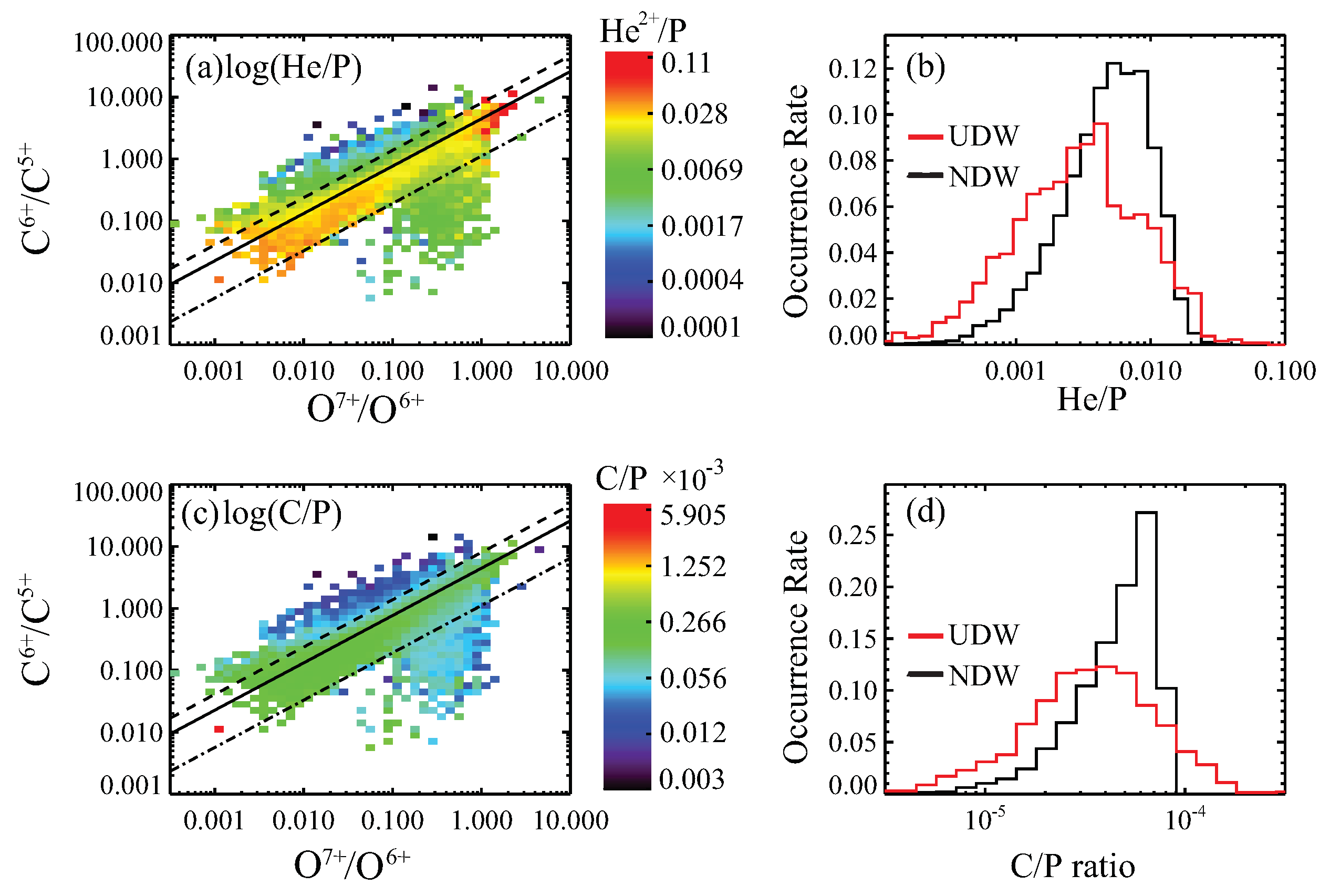
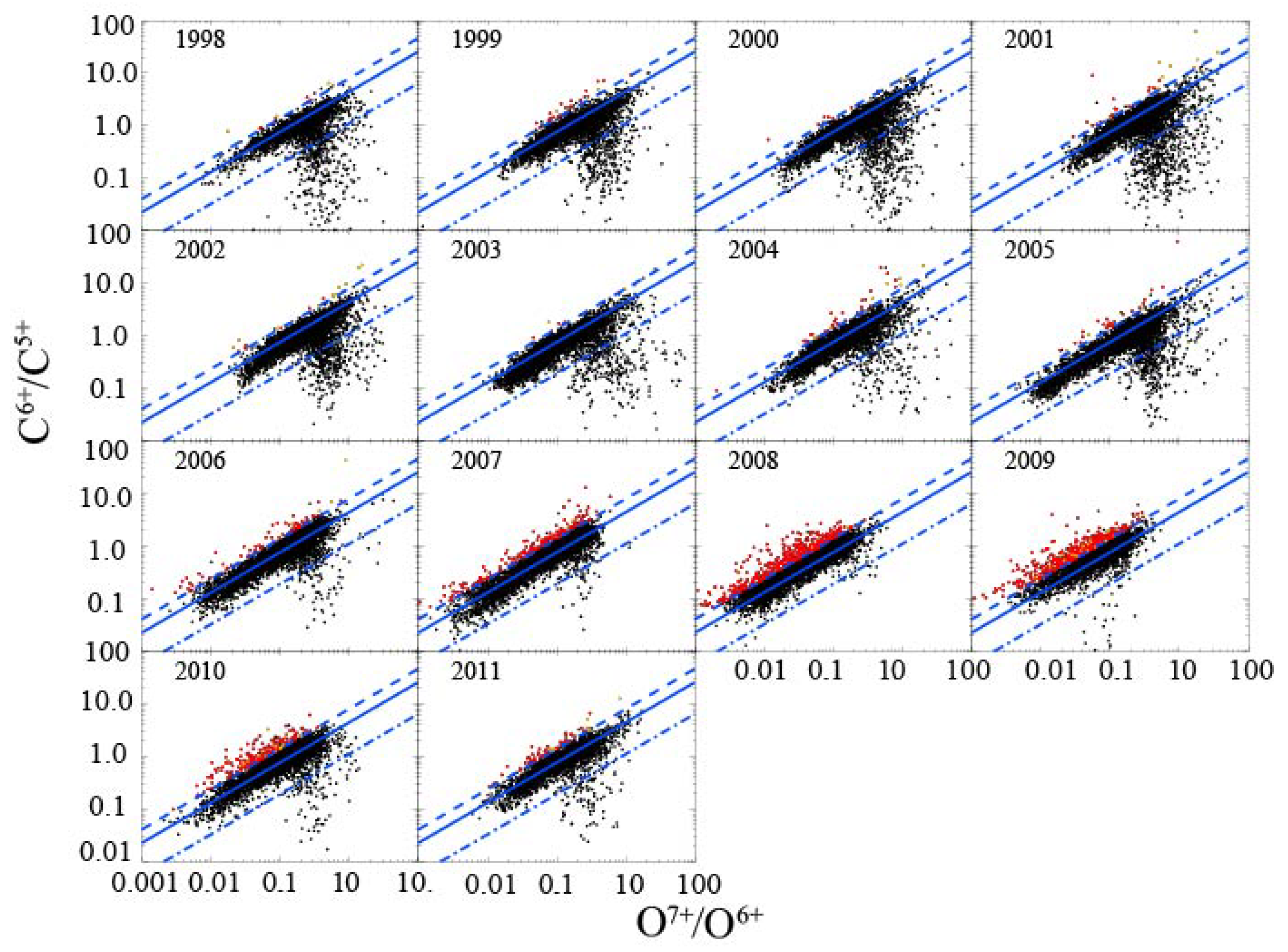
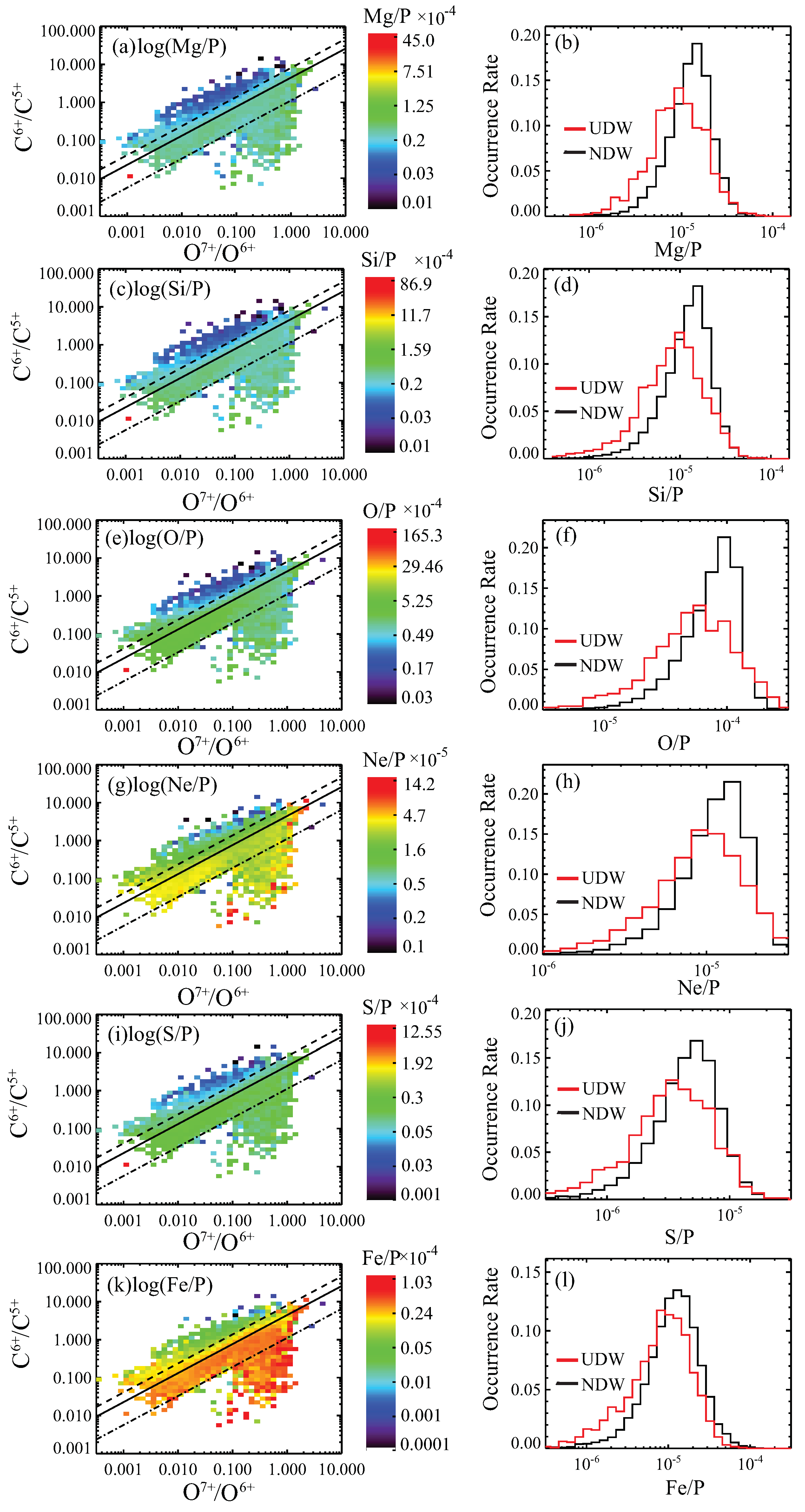
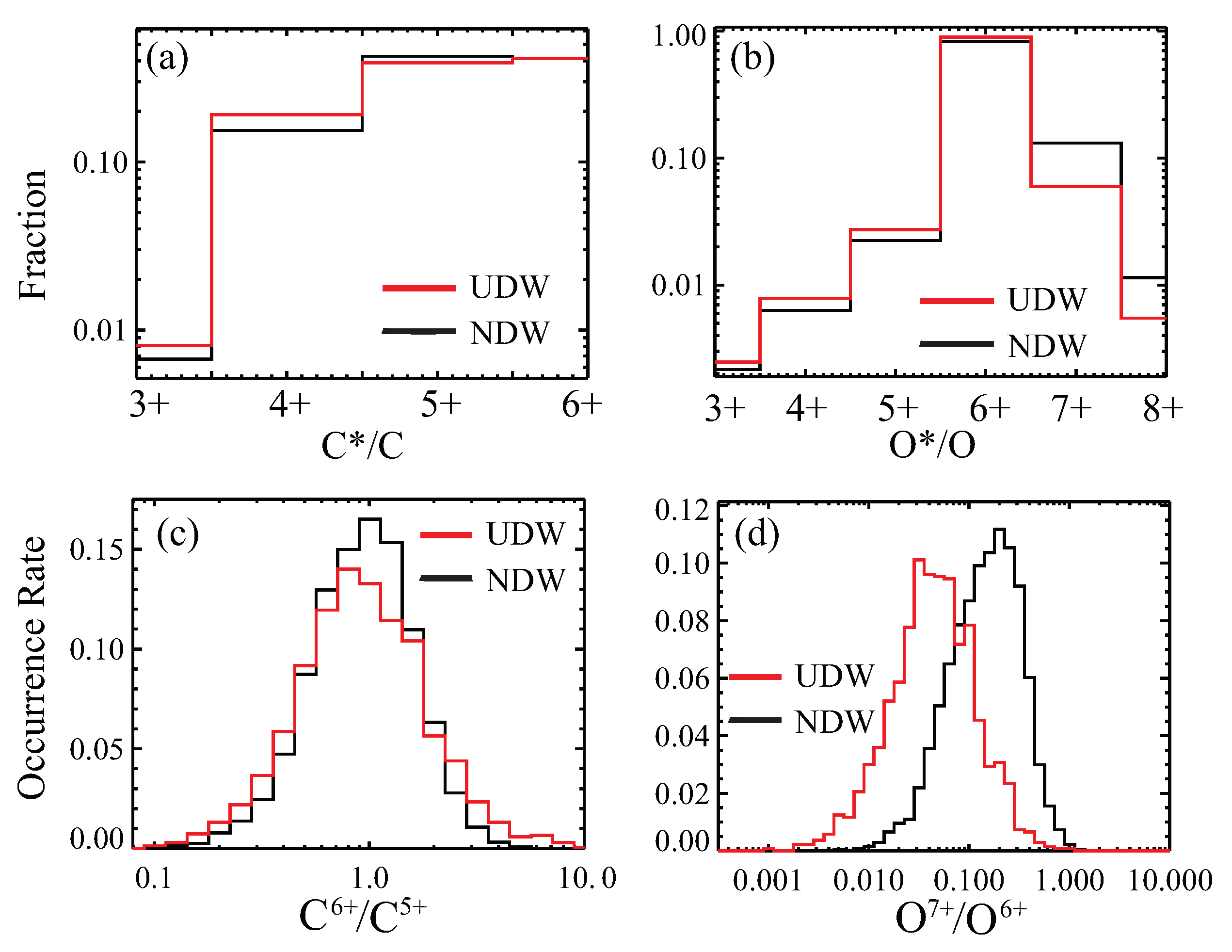
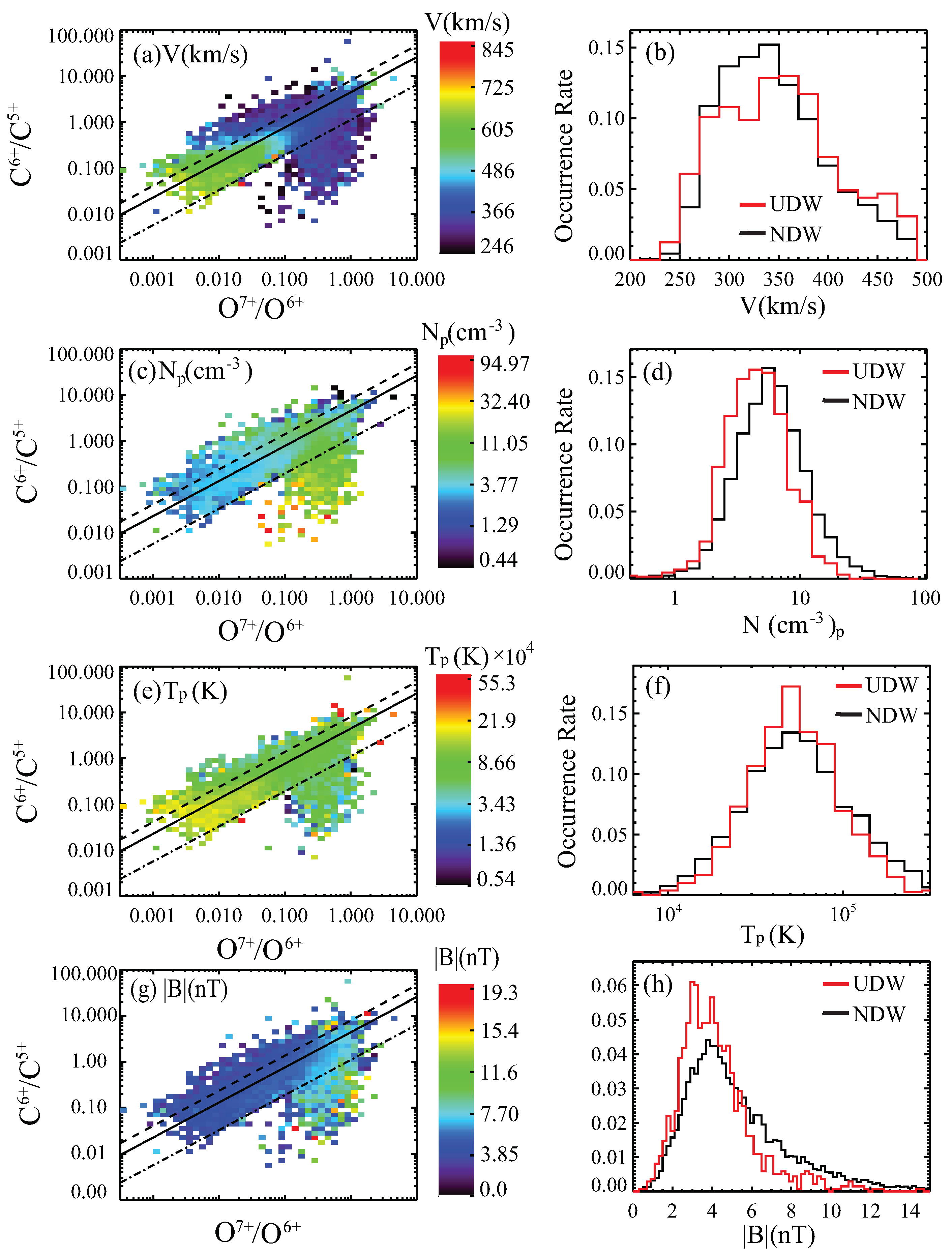


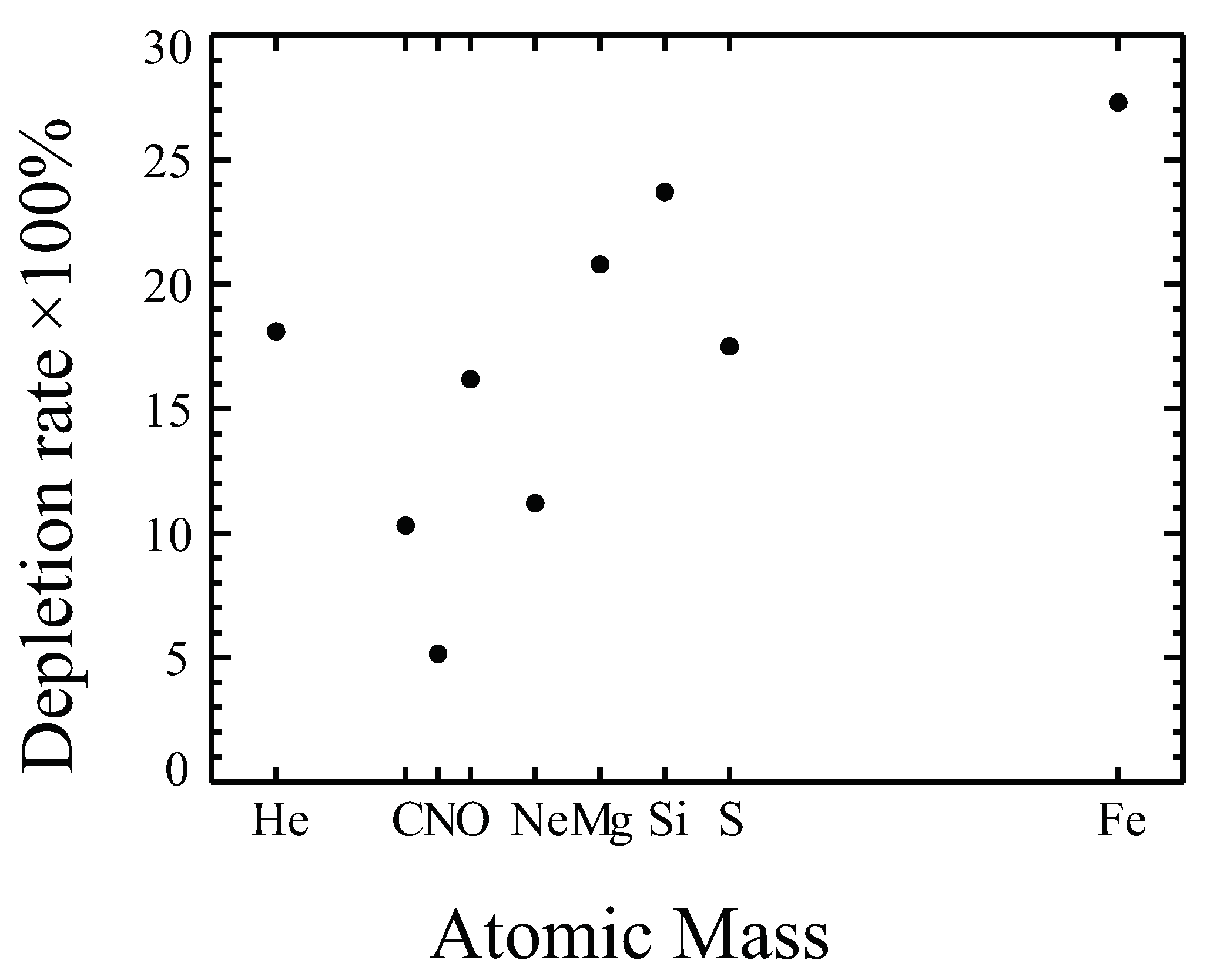
| Mean (Standard Deviation) | UDW | NDW | |
|---|---|---|---|
| He/P () | 5.38 (6.23) | 6.5 (4) | −17.5% |
| C/P () | 4.83 (3.8) | 5.37 (2.0) | −10.1% |
| Mg/P () | 1.23 (0.88) | 1.55 (0.75) | −20.8% |
| Si/P () | 1.18 (0.91) | 1.54 (0.83) | −23.6% |
| O/P () | 7.66 (6.03) | 9.03 (4.11) | −15.1% |
| Ne/P () | 1.20 (0.76) | 1.36 (0.61) | −11.5% |
| S/P () | 4.69 (3.53) | 5.69 (3.21) | −17.6% |
| Fe/P () | 1.18 (0.95) | 1.62 (1.22) | −27.1% |
| Mean (Standard Deviation) | UDW | NDW | |
|---|---|---|---|
| 0.41 (0.16) | 0.41 (0.14) | 0% | |
| 0.39 (0.09) | 0.42 (0.08) | −8.5% | |
| 0.0055 (0.02) | 0.011 (0.03) | −52.1% | |
| 0.060 (0.05) | 0.13 (0.08) | −54.5% | |
| 0.9 (0.06) | 0.83 (0.09) | 8.5% | |
| 1.38 (2.09) | 1.19 (0.67) | 16.8% | |
| 0.076 (0.089) | 0.21 (0.17) | −64.4% |
| Mean (Standard Deviation) | UDW | NDW | |
|---|---|---|---|
| V (km s) | 361.3 (59.2) | 355 (52) | 1.8% |
| N (cm) | 5.85 (3.56) | 8.00 (6.17) | −27.0% |
| T (K) | 6.96 (4.60) | 7.89 (6.35) | −11.8% |
| 4.33 (2.04) | 5.45 (2.89) | −20.6% |
| Pearson (Spearman) | UDW | NDW |
|---|---|---|
| SSN | −0.542 (−0.733) | −0.545 (−0.400) |
Publisher’s Note: MDPI stays neutral with regard to jurisdictional claims in published maps and institutional affiliations. |
© 2022 by the authors. Licensee MDPI, Basel, Switzerland. This article is an open access article distributed under the terms and conditions of the Creative Commons Attribution (CC BY) license (https://creativecommons.org/licenses/by/4.0/).
Share and Cite
Zhao, L.; Landi, E.; Lepri, S.T.; Carpenter, D. Depletion of Heavy Ion Abundances in Slow Solar Wind and Its Association with Quiet Sun Regions. Universe 2022, 8, 393. https://doi.org/10.3390/universe8080393
Zhao L, Landi E, Lepri ST, Carpenter D. Depletion of Heavy Ion Abundances in Slow Solar Wind and Its Association with Quiet Sun Regions. Universe. 2022; 8(8):393. https://doi.org/10.3390/universe8080393
Chicago/Turabian StyleZhao, Liang, Enrico Landi, Susan T. Lepri, and Daniel Carpenter. 2022. "Depletion of Heavy Ion Abundances in Slow Solar Wind and Its Association with Quiet Sun Regions" Universe 8, no. 8: 393. https://doi.org/10.3390/universe8080393
APA StyleZhao, L., Landi, E., Lepri, S. T., & Carpenter, D. (2022). Depletion of Heavy Ion Abundances in Slow Solar Wind and Its Association with Quiet Sun Regions. Universe, 8(8), 393. https://doi.org/10.3390/universe8080393






